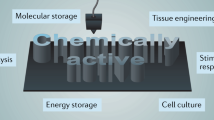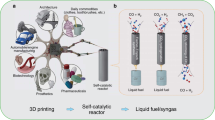Abstract
Three-dimensional (3D) printing has the potential to transform science and technology by creating bespoke, low-cost appliances that previously required dedicated facilities to make. An attractive, but unexplored, application is to use a 3D printer to initiate chemical reactions by printing the reagents directly into a 3D reactionware matrix, and so put reactionware design, construction and operation under digital control. Here, using a low-cost 3D printer and open-source design software we produced reactionware for organic and inorganic synthesis, which included printed-in catalysts and other architectures with printed-in components for electrochemical and spectroscopic analysis. This enabled reactions to be monitored in situ so that different reactionware architectures could be screened for their efficacy for a given process, with a digital feedback mechanism for device optimization. Furthermore, solely by modifying reactionware architecture, reaction outcomes can be altered. Taken together, this approach constitutes a relatively cheap, automated and reconfigurable chemical discovery platform that makes techniques from chemical engineering accessible to typical synthetic laboratories.
This is a preview of subscription content, access via your institution
Access options
Subscribe to this journal
Receive 12 print issues and online access
$259.00 per year
only $21.58 per issue
Buy this article
- Purchase on Springer Link
- Instant access to full article PDF
Prices may be subject to local taxes which are calculated during checkout






Similar content being viewed by others
References
Marks, P., Campbell, M., Aron, J. & Lipson, H. 3D printing: second industrial revolution is under way (special report). New Sci. 2823, 17–20 (2011).
Geissler, M. & Xia, Y. Patterning: principles and some new developments. Adv. Mater. 16, 1249–1269 (2004).
Nakamura, M., Iwanaga, S., Henmi, C., Arai, K. & Nishiyama, Y. Biomatrices and biomaterials for future developments of bioprinting and biofabrication. Biofabrication 2, 014110 (2010).
Lee, K-W., Wang, S., Dadsetan, M., Yaszemski, M. J. & Lu, L. Enhanced cell ingrowth and proliferation through three-dimensional nanocomposite scaffolds with controlled pore structures. Biomacromolecules 11, 682–689 (2010).
Hanson Shepherd, J. N. et al. 3D microperiodic hydrogel scaffolds for robust neuronal cultures. Adv. Funct. Mater. 21, 47–54 (2011).
Cohen, D. L., Malone, E., Lipson, H. & Bonassar, L. J. Direct freeform fabrication of seeded hydrogels in arbitrary geometries. Tissue Eng. 12, 1325–1335 (2006).
Stampfl, J. & Liska, R. New materials for rapid prototyping applications. Macromol. Chem. Phys. 206, 1253–1256 (2005).
Ahn, B. Y. et al. Omnidirectional printing of flexible, stretchable, and spanning silver microelectrodes. Science 323, 1590–1593 (2009).
Therriault, D., White, S. R. & Lewis, J. A. Chaotic mixing in three-dimensional microvascular networks fabricated by direct-write assembly. Nature Mater. 2, 265–271 (2003).
Ilievski, F., Mazzeo, A. D., Shepherd, R. F., Chen, X. & Whitesides, G. M. Soft robotics for chemists. Angew. Chem. Int. Ed. 50, 1890–1895 (2011).
Hasegawa, T., Nakashima, K., Omatsu, F. & Ikuta, K. Multi-directional micro-switching valve chip with rotary mechanism. Sensor. Actuat. A Phys. 143, 390–398 (2007).
Vilbrandt, T., Pasko, A. & Vilbrandt, C. Fabricating nature. Technoetic Arts 7, 165–174 (2009).
Pearce, J. M. et al. 3-D printing of open source appropriate technologies for self-directed sustainable development. J. Sustain. Develop. 3, 17–29 (2010).
Yager, P. et al. Microfluidic diagnostic technologies for global public health. Nature 442, 412–418 (2006).
Cook, T. R. et al. Solar energy supply and storage for the legacy and nonlegacy worlds. Chem. Rev. 110, 6474–6502 (2010).
Gratson, G. M., Xu, M. & Lewis, J. A. Microperiodic structures: direct writing of three-dimensional webs. Nature 428, 386 (2004).
Lewis, J. A. Direct ink writing of 3D functional materials. Adv. Funct. Mater. 16, 2193–2204 (2006).
Moore, J. L., McCuiston A., Mittendorf, I., Ottway, R. & Johnson, R. D. Behavior of capillary valves in centrifugal microfluidic devices prepared by three-dimensional printing. Microfluid. Nanofluid. 10, 877–888 (2011).
Fab@Home. The open-source personal fabricator project, http://www.fabathome.org (accessed 21/02/2012).
Malone, E. & Lipson, H. Fab@Home: the personal desktop fabricator kit. Rapid Prototyping J. 13, 245–255 (2007).
Parenty, A. D. C., Smith, L. V., Pickering, A. L., Long, D-L. & Cronin, L. General one-pot, three-step methodology leading to an extended class of N-heterocyclic cations: spontaneous nucleophilic addition, cyclization, and hydride loss. J. Org. Chem. 69, 5934–5946 (2004).
Richmond, C. J., Eadie, R. M., Parenty, A. D. C. & Cronin, L. Fine tuning reactivity: synthesis and isolation of 1,2,3,12b-tetrahydroimidazo[1,2-f] phenanthridines. J. Org. Chem. 74, 8196–8202 (2009).
Rhino3D, NURBS modeling for Windows, http://www.rhino3d.com (McNeel, Barcelona).
Kataria, A. & Rosen, D. W. Building around inserts: methods for fabricating complex devices in stereolithography. Rapid Prototyping J. 7, 253–261 (2001).
Kortz, U., Savelieff, M. G., Bassil, B. S. & Dickman, M. H. A large, novel polyoxotungstate: [As(III)6W65O217(H2O)7]26–. Angew. Chem. Int. Ed. 40, 3384–3386 (2001).
Tanaka, N., Unoura, K. & Itabashi, E. Voltammetric and spectroelectrochemical studies of dodecamolybdophosphoric acid in aqueous and water–dioxane solutions at a gold-minigrid optically transparent thin-layer electrode. Inorg. Chem. 21, 1662–1666 (1982).
Mandal, P. K. & McMurray, J. S. Pd–C induced catalytic transfer of hydrogen with triethylsilane. J. Org. Chem. 72, 6599–6601 (2007).
Boyle, M. M. et al. Mechanised materials. Chem. Sci. 2, 204–210 (2011).
Maldonado, A. G. & Rothenberg, G. Predictive modeling in homogeneous catalysis: a tutorial. Chem. Soc. Rev. 39, 1891–1902 (2010).
Browne, K. P., Walker, D. A., Bishop, K. J. M. & Grzybowski, B. A. Self-division of macroscopic droplets: partitioning of nanosized cargo into nanoscale micelles. Angew. Chem. Int. Ed. 49, 6756–6759 (2010).
Cooper, G. J. T. et al. Modular redox active inorganic chemical cells: iCHELLs. Angew. Chem. Int. Ed. 50, 10373–10376 (2011).
Murphy, R. F. An active role for machine learning in drug development. Nature Chem. Biol. 7, 327–330 (2011).
Acknowledgements
This work was supported by the Engineering and Physical Sciences Research Council UK via Creativity@HOME. L.C. thanks the Royal Society/Wolfson Foundation for a Merit Award. We thank R.M. Eadie (University of Glasgow) for samples of 2-bromoethylphenanthridinium bromide and E. Malone and K. Kondo (NextFab Studio, Philadelphia) for assistance with building the fabricator.
Author information
Authors and Affiliations
Contributions
L.C. conceived the idea and the organized the fabricator assembly, M.D.S., P.J.K., T.V., G.J.T.C. and R.W.B. designed the reactionware, M.D.S. and P.J.K. printed the devices, M.D.S., P.J.K., J.Y. and C.J.R. performed the experiments, L.C., M.D.S, P.J.K., J.Y. and C.J.R. analysed the results and M.D.S. and L.C. co-wrote the paper.
Corresponding author
Ethics declarations
Competing interests
The authors declare no competing financial interests.
Supplementary information
Supplementary information
Supplementary information (PDF 901 kb)
Supplementary Movie 1
Supplementary Movie 1 (MOV 15090 kb)
Supplementary Movie 2
Supplementary Movie 2 (MOV 9654 kb)
Supplementary information
Crystallographic data for compound 1 (CIF 37 kb)
Supplementary information
Crystallographic data for compound 2 (CIF 27 kb)
Supplementary information
Crystallographic data for compound 3 (CIF 15 kb)
Rights and permissions
About this article
Cite this article
Symes, M., Kitson, P., Yan, J. et al. Integrated 3D-printed reactionware for chemical synthesis and analysis. Nature Chem 4, 349–354 (2012). https://doi.org/10.1038/nchem.1313
Received:
Accepted:
Published:
Issue Date:
DOI: https://doi.org/10.1038/nchem.1313
This article is cited by
-
Ultrahigh-printing-speed photoresists for additive manufacturing
Nature Nanotechnology (2024)
-
Analysis of plant cuticles and their interactions with agrochemical surfactants using a 3D printed diffusion chamber
Plant Methods (2023)
-
Exploring metallic and plastic 3D printed photochemical reactors for customizing chemical synthesis
Scientific Reports (2022)
-
Complementary catalysis and analysis within solid state additively manufactured metal micro flow reactors
Scientific Reports (2022)
-
Additive Manufacturing of Functional Microarchitected Reactors for Energy, Environmental, and Biological Applications
International Journal of Precision Engineering and Manufacturing-Green Technology (2021)



